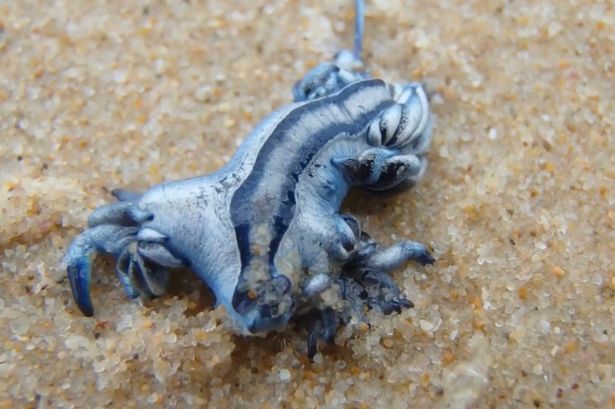World
Tourists Banned from Costa Blanca Sea Due to Dangerous ‘Blue Dragons’

Tourists visiting Spain’s Costa Blanca have been prohibited from entering the sea due to the discovery of the dangerous sea creature known as the “blue dragon.” This ban affects a seven-mile stretch of coastline, particularly in the area of Guardamar del Segura, following reports of the potentially lethal Glaucus atlanticus, which is renowned for its striking appearance and painful sting.
The local government issued red flags on beaches in Guardamar del Segura, just north of Torrevieja, after two blue dragons were spotted on Vivers Beach. Mayor José Luis Saez announced the ban via his official social media account, emphasizing the necessity of caution despite the creature’s small size of approximately 1.5 inches and beautiful coloration.
The blue dragon preys on the venomous Portuguese man o’ war and other toxic marine organisms, hoarding their stinging cells to deliver a far more potent sting than its prey. Symptoms from a blue dragon sting include nausea, pain, vomiting, and severe allergic reactions. The Town Hall of Guardamar del Segura has implemented a preventive operation to monitor the situation and detect any additional specimens carried by ocean currents.
In his statement, Mayor Saez advised the public, “If you see one of these creatures, don’t touch it, even with gloves on. Alert lifeguards and other authorities.” He further instructed that if stung, individuals should rinse the affected area with salt water and seek immediate medical assistance at the nearest first aid point or health centre.
Despite the warnings, many visitors flocked to Vivers Beach, with some disregarding the bathing prohibition and risking fines by entering the water. Lifeguards are expected to use loudhailers to remind beachgoers of the ban and ensure compliance. While swimming is off-limits, sunbathers can still enjoy the beaches.
The situation echoes similar incidents in the region, such as at Santa Barbara Beach in La Linea de la Concepcion near Gibraltar, where red flags were raised following an emergency call about blue dragon sightings. Six specimens were later found on the beach, leading to temporary closures. The area reopened to bathers the following day with a yellow warning flag, indicating caution.
Authorities continue to monitor the presence of these creatures along the coast, and the ban remains in effect until further notice. The stunning yet hazardous blue dragon serves as a reminder of the ocean’s unpredictable nature and the need for vigilance among beachgoers.
-

 Entertainment3 months ago
Entertainment3 months agoAnn Ming Reflects on ITV’s ‘I Fought the Law’ Drama
-

 Entertainment4 months ago
Entertainment4 months agoKate Garraway Sells £2 Million Home Amid Financial Struggles
-

 Health3 months ago
Health3 months agoKatie Price Faces New Health Concerns After Cancer Symptoms Resurface
-

 Entertainment3 months ago
Entertainment3 months agoCoronation Street’s Carl Webster Faces Trouble with New Affairs
-

 Entertainment3 months ago
Entertainment3 months agoWhere is Tinder Swindler Simon Leviev? Latest Updates Revealed
-

 World2 weeks ago
World2 weeks agoBailey Announces Heartbreaking Split from Rebecca After Reunion
-

 Entertainment4 months ago
Entertainment4 months agoMarkiplier Addresses AI Controversy During Livestream Response
-

 Entertainment2 weeks ago
Entertainment2 weeks agoCoronation Street Fans React as Todd Faces Heartbreaking Choice
-

 Science1 month ago
Science1 month agoBrian Cox Addresses Claims of Alien Probe in 3I/ATLAS Discovery
-

 Health4 months ago
Health4 months agoCarol Vorderman Reflects on Health Scare and Family Support
-

 Entertainment4 months ago
Entertainment4 months agoKim Cattrall Posts Cryptic Message After HBO’s Sequel Cancellation
-

 Entertainment3 months ago
Entertainment3 months agoOlivia Attwood Opens Up About Fallout with Former Best Friend





















